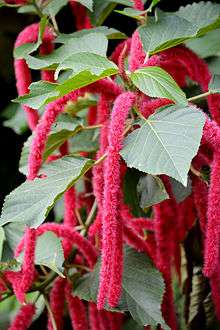Acalypha hispida
| Chenille Plant | |
|---|---|
 | |
| Scientific classification | |
| Kingdom: | Plantae |
| (unranked): | Angiosperms |
| (unranked): | Eudicots |
| (unranked): | Rosids |
| Order: | Malpighiales |
| Family: | Euphorbiaceae |
| Subfamily: | Acalyphoideae |
| Tribe: | Acalypheae |
| Subtribe: | Acalyphinae |
| Genus: | Acalypha |
| Species: | A. hispida |
| Binomial name | |
| Acalypha hispida | |
Acalypha hispida, the Chenille plant, is a flowering shrub which belongs to the family Euphorbiaceae,[1] the subfamily Acalyphinae, and the genus Acalypha. Acalypha is the fourth largest genus of the Euphorbiaceae family, and contains many plants native to Hawaii and Oceania.[2] This plant is also known as the Philippines Medusa, red hot cat's tail and fox tail in English, pokok ekor kucing in Malay, Rabo de Gato in Portuguese, Tai tượng đuôi chồn in Vietnamese and shibjhul in Bengali. Acalypha hispida is cultivated as a house plant because of its attractiveness and brilliantly colored, furry flowers.
Origins
The plant originated in Oceania,[2] but has become naturalized to multiple countries in North America, including the United States, Mexico, and Belize. It can grow to be five[1] to twelve feet (1.8-3.7 meters) tall, and have a spread of three to six feet (0.9-1.8 meters), with potted plants being the smallest in growth.[2] The plant has become somewhat domesticated, due to the nature and color of its flowers. It can be grown from seeds as well as from cuttings. It can be kept either as an outdoor plant or as a houseplant. However, care should be taken in growing it, as all parts of the plant are poisonous if ingested by animals.
Characteristics
The plant is dioecious, and therefore there are distinct male and female members of the species. The female plant bears pistillate flowers which range in color from purple to bright red, and grow in clusters along catkins.[2] This feature is the primary reason the plant bears the nickname “red-hot cat tail”. The pistillates will grow all year long as long as the temperatures are favorable.[2]
References
| Wikimedia Commons has media related to Acalypha hispida. |
- 1 2 "Acalypha hispida Chenille Plant". University of Florida. Retrieved 22 September 2011.
- 1 2 3 4 5 "Acalypha hispida". Floridata. Retrieved 22 September 2011.
External links
- Acalypha hispida Burm. f. Medicinal Plant Images Database (School of Chinese Medicine, Hong Kong Baptist University) (traditional Chinese) (English)
Galleries
-
Chenille plant from vamban KVK
-
Katzenschwänzchen - Acalypha hispida
-

Acalypha hispida